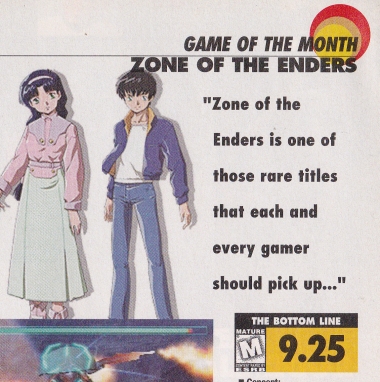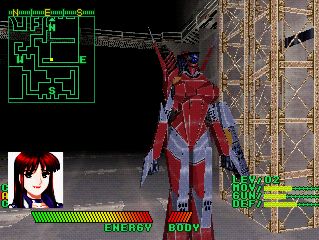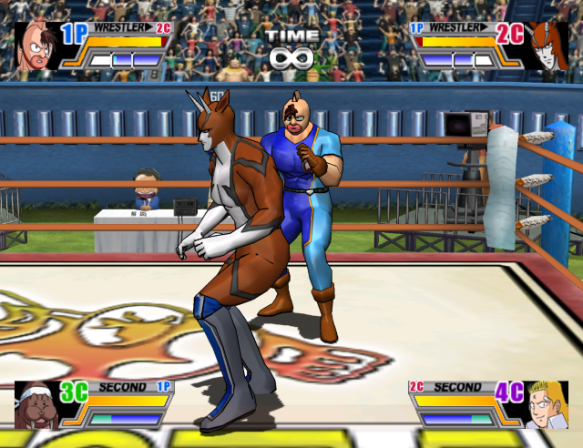Game Informer magazine issue #97 (May 2001) has easily one of the crappiest game to be featured on the cover of that or any other game magazine. The only competition I can think of is the latest Star Trek title or South Park Rally. See, the Xbox was nearing launch and Microsoft was dishing out exclusives to each outlet. GI was still pretty low on the totem, thus we got Azurik – one of the launch games everyone either forget or wish they had.
It also marked my second issue as associate editor. I had started in October 1999 as a web editor (leaving my awesome job as a slave of Gwar). Less than a year and a half later, the same parent company that demanded Game Informer hire a dedicated web staff to make a dedicated website said to shut down the site and lay off some people. I was very fortunate to be kept on and moved over to the print side.
I definitely made some mistakes as a rookie reviewer. My first high-profile review assignment was Zone of the Enders, a PS2 action game where you play a kid in a mech (giant robot) who has to save the world. It was from Hideo Kojima, the man behind the Metal Gear series (as well as another favorite, Snatcher).

After an hour or two, it was pretty obvious this was a quality title. Thank goodness, as there were few other standout games that issue. Baseball games and Super Bombad Racing were about all PS2 had going for it; Xbox and GameCube were months from launch; GBA wasn’t out yet either; and Dreamcast, N64 and PSone were limping along. Though I will say this issue also featured Mars Matrix (buy it), one of my favorite shmups of all time.
Anyway, a game this good meant a large-sized review and possibly Game of the Month. That entailed lots of screenshots – at least a few of them big ones. Back then, we took screens by splitting the video out to our Macs (G4s?). We’d hit space bar, and it would capture the image. PS2 brought about anti-aliasing, which created some ghosting in our images. We found a workaround, but it left the shots looking lower-resolution. Add to that the fact that I was apparently capturing at 320×240 instead of 640×480, and most of my shots were unusable. D’oh. I don’t remember if I had time to go back and recapture shots or not; even if I did, they wouldn’t have been as versatile and organic as the originals.
My second faux pas was more egregious, and I am putting myself out there in admitting it (though you know already, having read the title of this entry). The plot of Zone of the Enders has you piloting this mech that your young avatar Leo quite literally fell into. He wants to save his city while the mech’s AI needs to get its ass to Mars – where an even bigger battle is being waged. So about 5 hours in, maybe more if you count my time taking notes and snapping screens, I’m approaching when I’ll be taking off for Mars – which I assume is the second half or so, in part due to an overhead map in a cutscene.
By then, I’m feeling pretty good about calling it. The gameplay is satisfying and speedy; the graphics are excellent (remember PS2 tech was still considered next-gen); there’s even a little story, albeit with a whiny kid. This is our Game of the Month, I say confidently. I write my review, give it a 9.25, and the reviewer doing the second opinion goes a quarter-point higher with a 9.5. I even say “Unlike a few other PS2 efforts thus far, this is a pretty long game to boot.” You can check out a PDF of the entire review if you feel so inclined.
Fast-forward to this month, May of 2013. 12 years after that issue and that review came out. I’ve had a shrinkwrapped copy of Zone of the Enders ever since, having never played it post-review. I’ve had cravings to pop it in, but it’s just too damn valuable to break the seal. I own a used, mint copy of the sequel, too – Zone of the Enders: The 2nd Runner – but haven’t played that, either. And I hear ZOE 2 is better in every way.
Fortunately, Konami put out ZOE HD Collection (buy here) last October. Unfortunately, it was said to be rife with issues – especially reduced speed of combat. Fortunately, it was patched (though the Xbox 360 version is said to be superior). Unfortunately, it came out during my year-long game-buying ban. Fortunately, I found it on sale so cheap I couldn’t pass it up.
So I played it, a 12-year-old game with a glossy paint job. I see why I liked it so much. Combat is manic and often zero-gravity, but there’s a bit of strategy to it. It’s faithfully to what I remember. Not everything stood up so well, though. I can’t believe how much backtracking there is. It seems that, with every new area that opens up on the map, you have to revisit every previous one to find a specific item or weapon or unmanned enemy to take over. At least you can level-up along the way, and the sub-weapons you find are pretty cool.

The missions have some variety, but there are really only 2 normal enemy types, and one of them is a major pain in the ass. Boss battles, what few there are, are Kojima-worthy. You even get a cool continue screen if you die. Protagonist Leo can be grating, but he’s pretty human as far as game characters go. The way he and navigation AI Ada speak to one other kept me entertained.
But here’s the kicker: Back when I stopped playing Zone of the Enders to write my review, I was probably an hour away from completing the whole game. My total play time, which ended Tuesday night, was 5 hours, 51 minutes and 40 seconds. And I am not a rushed-style player. The game ends before you even get to Mars; I’m assuming Mars is where ZOE 2 takes place (which I heard isn’t much longer than 6 hours itself).
This was not a surprise, honestly. Even though we didn’t have social media back then, I’d quickly heard about the short length of the game. After that, I unofficially decided to put more time into games I was reviewing. I won’t say that I beat every one – there were times when I reviewed 20 games in one issue, or times I had less than a day to play/write/submit a review as a freelancer – but I did give each of them more of a chance.
I don’t know what I would have given Zone of the Enders had I known its actual length. Maybe it still would have been GI’s Game of the Month. After all, it had a lot going for it in its day. But it’s tough to say this many years later when much of what made it special has been usurped tenfold. I know I became a much better reviewer, in part because of that and other mistakes I made.
— Justin Leeper (@StillManFights)
























 I decided to revisit the 2011 list. I own(ed) 32 of those games, and have beaten 8 of them. Now, some may have been purchased in 2012, so there’s not a direct correlation. Still, it’s a big difference, isn’t it? That’s 350% more than the 2012 list, but I beat only 25% of them compared to 45% of the 2012 games, even with the extra time. I guess that shows a portion of my backlog. Here’s the list of games owned/beaten from the 2012 list:
I decided to revisit the 2011 list. I own(ed) 32 of those games, and have beaten 8 of them. Now, some may have been purchased in 2012, so there’s not a direct correlation. Still, it’s a big difference, isn’t it? That’s 350% more than the 2012 list, but I beat only 25% of them compared to 45% of the 2012 games, even with the extra time. I guess that shows a portion of my backlog. Here’s the list of games owned/beaten from the 2012 list: 



